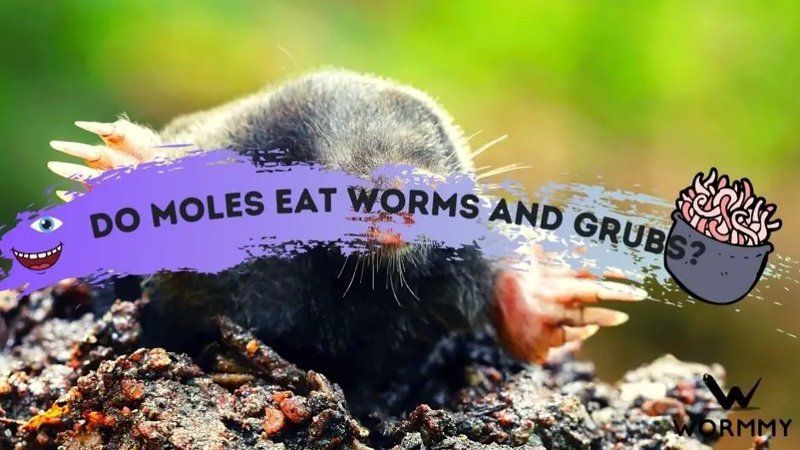
Moles are fascinating creatures that spend most of their lives underground. They tunnel through the earth, searching for their next meal and, unfortunately, causing havoc in our lawns. Grub worms, on the other hand, are larval forms of beetles, often found lurking beneath the surface of your grass. They feed on roots and can wreak their own kind of havoc. When moles find grubs in your yard, it’s like finding your favorite snack—it’s hard for them to resist. Let’s explore how these two critters interact and what it means for your garden.
What Are Moles?
Moles are small, burrowing mammals known for their cylindrical bodies and velvety fur. With their impressive digging abilities, they can create an extensive network of tunnels underground. Interestingly, moles have tiny, almost invisible eyes and are nearly blind, relying heavily on their sense of touch. They’ve got these cool, paddle-like feet that are perfect for digging through soil, making them expert excavators.
You might be wondering what they eat. Moles primarily feast on insects, earthworms, and, yes, *grub worms*. They can consume their body weight in food in a single day, which is a lot considering a mole typically weighs around 0.5 ounces! Their diet plays a big role in controlling pest populations, which is a double-edged sword in gardens, especially if you’re growing your own produce.
Because moles spend so much time underground, they tend to be secretive. This can make them tough to spot, but if you notice telltale signs like raised tunnels or mounds of soil, it’s a good indication that moles are living in your yard.
Understanding Grub Worms
Grub worms are the larval stages of certain beetles, mainly Japanese beetles, June bugs, and other species. They usually live in the soil, where they munch on grass roots and decaying organic material. These little guys can be quite destructive, especially when they are in large numbers. Just picture a swarm of tiny pests dining on the roots of your grass—it’s not a pretty sight!
Grubs go through several stages in their lifecycle, starting as eggs laid in the soil by adult beetles. After a few weeks, these eggs hatch into grubs. They feed and grow, usually from late summer into fall, before they pupate and turn into adult beetles, repeating the cycle. If you’re noticing brown patches in your lawn, it could be a sign of heavy grub infestation.
Now, what’s really interesting is how moles locate these grubs. With their keen sense of touch, they can feel vibrations in the ground, helping them find these tasty larvae. If you think about it, it’s like having a GPS that leads them straight to their dinner, making your yard an all-you-can-eat buffet if grubs are present.
The Relationship Between Moles And Grub Worms
So, why should you care about the connection between moles and grubs? Well, it boils down to the food chain. Moles are naturally attracted to areas with a high grub population because they provide a reliable food source. If your lawn is teeming with grubs, it could be like a neon sign for moles saying, “Come and eat!”
However, this relationship can create challenges. While moles help control grub populations, their burrowing can leave your yard looking like a war zone. They dig up roots, disrupt soil aeration, and can even harm other beneficial organisms in the ground. In a way, it’s a delicate balance—the presence of moles indicates a grub issue, but their solution can cause more problems.
You might want to think about if the grubs are a problem in your yard as well. If you see a lot of moles, there’s a good chance they’re feasting on the grubs lurking below. This could mean it’s time to focus on managing the grub population before it gets out of hand, or you might end up with a mole problem that’s hard to handle.
How To Control Grub Populations
If you’ve discovered that grubs are a problem in your garden, there are several effective strategies you can use to manage their population. Here are some options to consider:
- Beneficial Nematodes: These microscopic organisms can be introduced to your soil. They attach to grubs and help kill them, reducing their numbers naturally.
- Milky Spore: This is a bacterial disease that targets Japanese beetle grubs. It can establish a long-term control option in your lawn, working for years.
- Organic Insecticides: Look for products specifically designed to target grubs but are safe for beneficial insects. Always follow application guidelines for safety.
- Regular Lawn Maintenance: Keeping your lawn healthy with proper watering and fertilization can help it withstand grub damage. Healthy grass can grow back even after some grub activity.
Each of these methods has its own pros and cons, so it’s worth researching them further to see which one fits your needs best.
How To Deter Moles
If you’ve got moles wreaking havoc because of grub presence, there are ways to deter them from settling in. Here are some strategies to consider:
- Repellents: Natural repellents like castor oil can be applied to the soil. Moles tend to dislike the smell and may move on to find more appealing grounds.
- Vibration Devices: There are sonic or vibrating stakes available that can be placed in your yard. Moles dislike vibrations and might avoid areas with these devices.
- Trapping: This is the most effective way of removing moles. If you feel comfortable, you can set up traps in active mole tunnels to capture them.
- Maintain a Clean Yard: By keeping your yard free of excess debris, you can minimize the appealing habitat for both grubs and moles.
Using these methods can help you strike a balance between controlling the grub population and keeping moles at bay.
The Importance of a Balanced Ecosystem
Ultimately, both moles and grubs play roles in our ecosystem. Moles aerate the soil, improving its quality, while grubs recycle organic matter. If we can find ways to manage them without disrupting the entire system, everyone wins.
By addressing the grub problem, you’re not just making your yard mole-free; you’re helping your grass thrive. Healthy lawns often have fewer grubs, which makes it less likely for moles to come looking for a meal. It’s a classic case of “solve the root problem, and you’ll tackle the symptoms.”
Think of your garden as a holistic system; when one part is out of balance, it can affect everything else. By understanding the connection between moles and grub worms, you’ll be able to take steps to ensure your yard remains a beautiful, thriving space.
In conclusion, the complex relationship between moles and grub worms is a dance that can be managed with the right approach. With a little knowledge and effort, you can keep your yard healthy and minimize the impact of these critters. Happy gardening!

